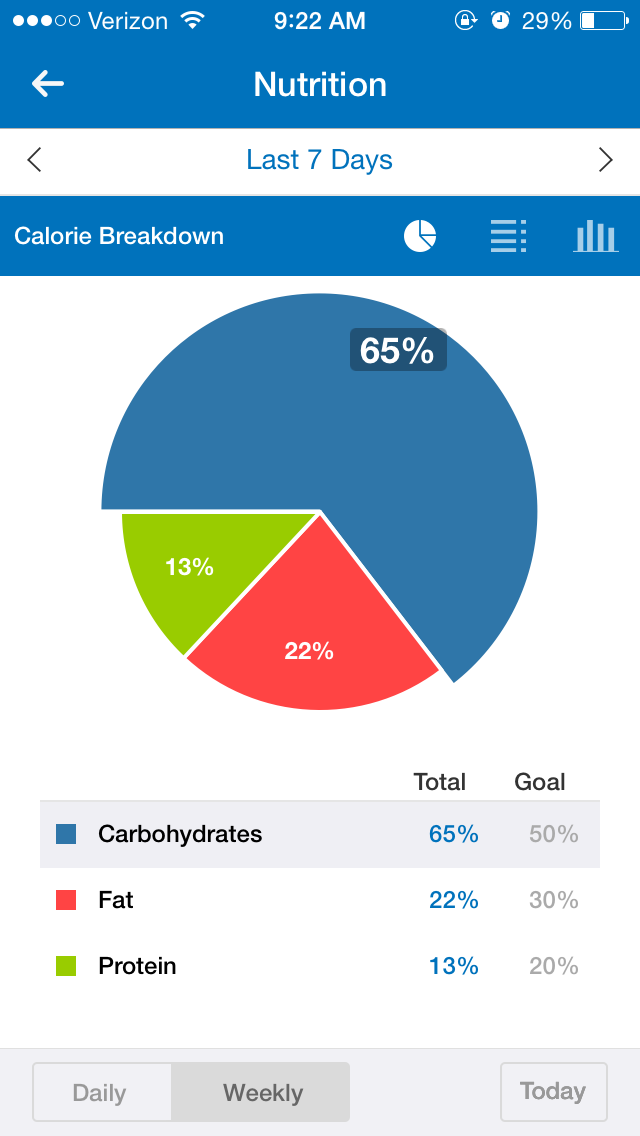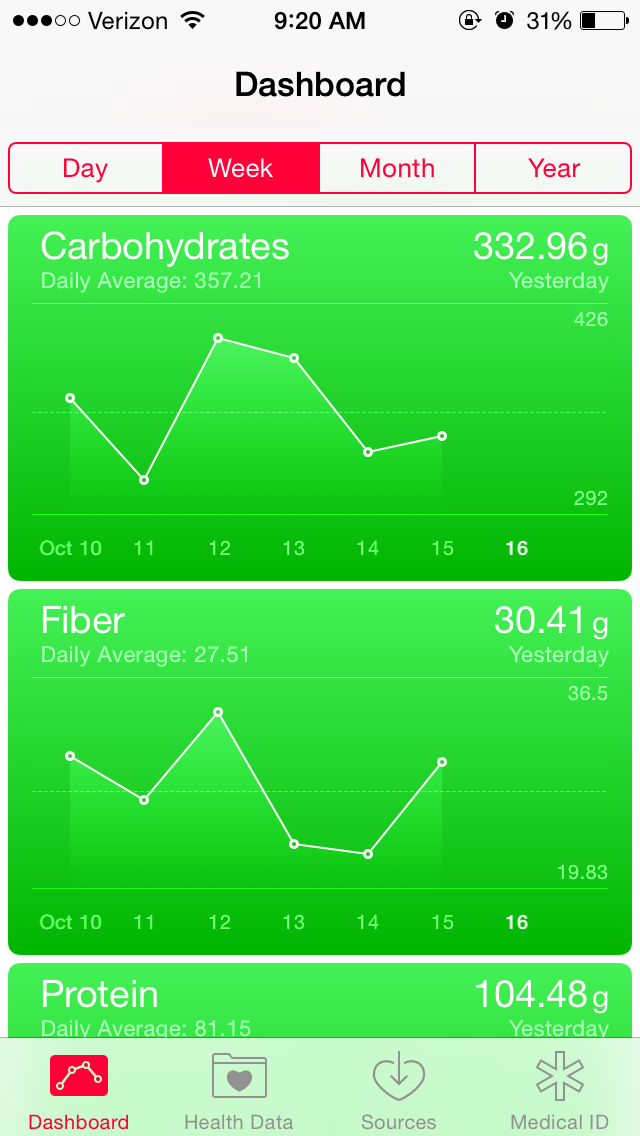Quantified Health and Software Apps
I went on a bit of a Twitter rant last night, about how MyFitnessPal doesn’t give me much helpful data:
Myfitnesspal is a good food-tracking app, but wish data were more helpful. (1/?)
— Sarah K Moir (@smorewithface) October 16, 2014
While it’s called MyFitnessPal, it doesn’t feel much like a pal, and feels more like a diet app than a fitness app:
Chides me when my foods go outside of goal ranges, but doesn’t use info about past meals or habits to make suggestions (2/?) — Sarah K Moir (@smorewithface) October 16, 2014
It’s like a friend congratulating you for eating a lot of whole wheat, but making a face because the egg you ate has a lot of cholesterol in it, even if it’s the only egg you’ve eaten that week.
Doesn’t track trends and offer recipes or workouts to combat them. Health and nutrition is subjective yes but I want more. (3/?) — Sarah K Moir (@smorewithface) October 16, 2014
The data it’s gathering, which for me is about four months of data, isn’t used to show any trends or to turn the data into more meaningful advice. As I point out, health and nutrition is subjective – while I may be focusing on eating more whole grains and vegetables, others may want to make sure they’re hitting a protein goal, or staying away from certain kinds of fat.
If I’m sharing all that data with an app, I want to get more out of it than a constant reminder that I eat too many carbs. (4/?) — Sarah K Moir (@smorewithface) October 16, 2014
There is a congratulatory and gentle chiding aspect to feedback, but nothing motivational. (5/?) — Sarah K Moir (@smorewithface) October 16, 2014
No, wow you’ve eaten veggies every day this week, keep it up! Or hmm you’ve been eating chocolate, try other foods to boost energy (6/?) — Sarah K Moir (@smorewithface) October 16, 2014
Congratulating trends that occur long-term, in addition to in-the-moment feedback, would be even more beneficial. Long-term trends are habits, after all. It’s great if I eat sweet potatoes because they have a lot of Vitamin A, but if they’re the only vegetable I’ve eaten that week, it could be beneficial to suggest other options. It could be a food that goes along with sweet potatoes, or a recipe that incorporates sweet potatoes in it, to encourage me to eat more variety yet maintain a healthful habit and food choice. Reward and help build habits, not day-to-day behavior.
(Not to mention there is no good way to track mood alongside nutrition but that’s another app, + privacy concerns) (7/?) — Sarah K Moir (@smorewithface) October 16, 2014
A bit of a detour from the expectations I have from a food-tracking app, tying together nutrition and mood tracking seems logical. Given the increasing evidence that ties together the microbiome of the gut and mood, as well as the role that nutrition plays in maintaining the health of that microbiome, it seems clear that mood tracking is the next step for apps to tackle.
(There are a lot of mood tracking apps out there (and I will be investigating them).)
There are clear privacy concerns in tracking your mood using a smartphone app, and the methods used to gather that data could be subjective, inconsistent, or raise more privacy concerns, but there is a benefit in exploring correlations between nutrition and mood. Mood tracking alongside nutritional trends is also beneficial alongside period tracking, but given that neither mood nor period tracking are included in Apple’s Health app, correlations can’t yet be drawn with this data.
Sad that most food tracking apps are diet and calorie based rather than nutrition and personal goal based (8/?) — Sarah K Moir (@smorewithface) October 16, 2014
It bugs me that the MyFitnessPal app revolves heavily around calories as a tracking metric. While it records nutritional information about protein and carbs, and those are visible in a different view of the app, the primary metric that is tracked is still calories. If someone wanted to create a diet or a nutritional goal that tracks protein or carbohydrate intake, a different view needs to be used, and the data is only shared in aggregate. I can look at a day’s nutrition to see where I’ve gone over my limit, but I can’t see which food had the saturated fat I wasn’t supposed to eat, or which food had the largest percentage of my carbohydrate intake. Nutrition data is available, but not in a valuable format.
Where do I go to track food intake for nutrition and health, rather than “fitness” and diet? (9/?) — Sarah K Moir (@smorewithface) October 16, 2014
I can see at a glance that the cheez-its I snacked on were almost 400 calories, but not that it’s the only source of bad fats in my diet for the day. The app is much more passive when it comes to nutrition. The ability to understand the food we eat, and the habits to change, relies on a better understanding of where the nutrition we eat is coming from.
I can make my own assumptions from the data, but there’s no narrative, and no mechanism for me to build my own outside of weight loss (10/?) — Sarah K Moir (@smorewithface) October 16, 2014
Without a diligent monitoring of the “nutrition” interface, and viewing my protein, fat, and carbohydrate intake as a series of pie charts (on a daily or weekly basis), there is no way to build an understanding of trends, let alone identify habits. There is no long view available. 
If I eat more carbohydrates toward the end of the month, or tend to cycle between healthy weeks followed by more unhealthy weeks, I won’t know. The focus is less on health and nutrition, and defaults to a tracking of weight and caloric intake. Given that my weight has hovered in the same four pound range since I started tracking the app, a weight-based metric is not valuable to me. A nutrition-based metric, however, is.
Quantified self sads I guess. Too much data and little value wrought (11/11) — Sarah K Moir (@smorewithface) October 16, 2014
I added MyFitnessPal’s data to Apple’s Health app in an attempt to create this more meaningful narrative for myself. Liberate the data and be able to do something else with it outside the app. But so far, all I can do with the nutritional data is look at it as a series of line graphs. 
I can’t even view the lines superimposed on the same graph to notice correlations. Not to mention that the data is displayed in grams; which is totally meaningless when it comes to gathering value from the information. These software apps act essentially as repositories, nothing more.
This challenge isn’t unique to these two apps. I discuss them because I use them, but they represent a greater issue—we have more data than we know what to do with, and lack the analytics and ability to turn this data into meaningful narratives for people. I can track calories by hand, but drawing conclusions about trends in my nutritional habits is something that software is better-suited to than I am. Make it easier to do the hard stuff, not easier to do the easy stuff.